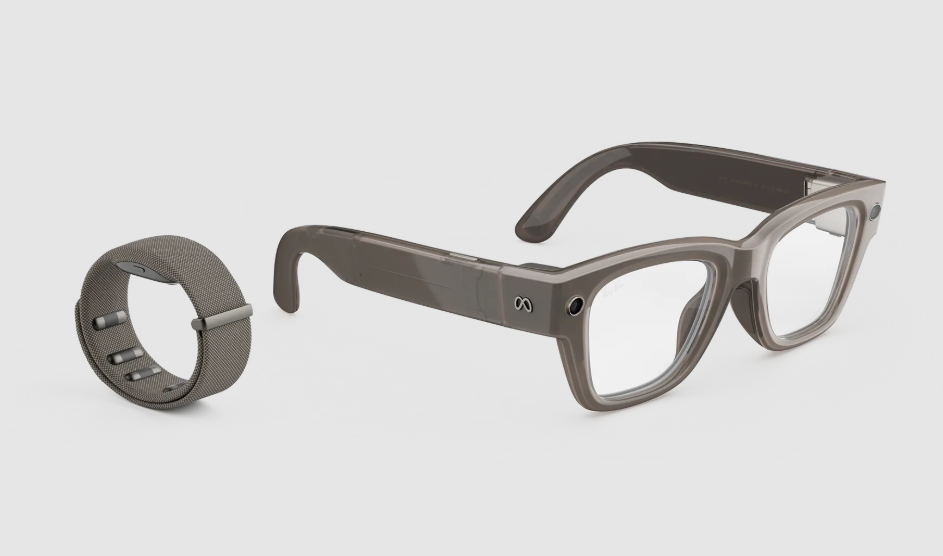
Meta Platforms Inc. is racing ahead of its competitors in the virtual reality and augmented reality worlds with the launch of a new and more sophisticated pair of Ray-Ban branded smart glasses.
It debuted alongside a new technology called Hyperscape, which enables Meta’s VR headset Quest to replicate real-world spaces in a virtual environment.
Meta founder and Chief Executive Mark Zuckerberg took to the stage late today at the company’s annual Meta Connect event, where he showcased the company’s next-generation smart glasses. They’re called the Meta Ray-Ban Display, and unlike the original Ray-Ban Meta specs, they come with a built-in display on the right lens. It’s visible only to the wearer, and meant to show various applications, notifications and directions.
The smart glasses can be controlled by a special wristband called the Meta Neural Band, which picks up on the user’s gestures. There’s an integrated AI assistant that allows for voice controls so users can navigate through social media applications and browse the internet, and the specs also feature a built-in camera, speakers and microphone.
Meta Ray-Ban Display is a notable upgrade that makes it possible for smart glasses to do pretty much any task that can be done on a smartphone, and if it can popularize the concept it could be a game-changer for the company. For years, Meta has been forced to reach its users through third-party devices such as Apple Inc.’s iPhones, Google LLC’s Android phones and Microsoft Corp.’s Windows computers, but with the Ray-Ban Display, it now owns the hardware as well as the software.
Onstage, Zuckerberg spoke about all of the different things users will be able to do with Meta Ray-Ban Display that couldn’t be done with the company’s original smart glasses. The most important thing is the display, which allows users to view posts in their Facebook feed and messages on apps like WhatsApp and Instagram, as well as live translations.
The Neural Band that ships with the device is similar to something like a Fitbit fitness device, and its purpose is to give users a way to navigate apps in Ray-Ban Display using small hand movements. It uses a technology known as electromyography, which picks up on the signals sent between the brain and the hand when performing gestures, Zuckerberg explained. He also mentioned that it’s water-resistant, just like the smart glasses, and has 18 hours of battery life.
It should be noted that Meta Ray-Ban Display lacks some of the features seen on Meta’s prototype Orion smart glasses, which were shown off by Zuckerberg at Connect 2024. The Orion came with augmented reality lenses that could overlay graphics directly on the lens, and had an eye-tracking system to understand what people are looking at. Meta Ray-Ban Display, on the other hand, only has a small display integrated with what is otherwise just a standard lens.
The good news is that consumers will be able to get their hands on Meta Ray-Ban Display soon. Zuckerberg said it’s going on sale in the U.S., Canada, the U.K., France, Italy, Spain, Austria, Belgium, Australia, Ireland, UAE, Germany, Sweden, Norway, Finland, Denmark, Switzerland and the Netherlands at the end of this month, with a price tag of $799. It’s also going to launch in Brazil and India “soon.”
More AI smarts and longer battery life
Those who don’t find the idea of an integrated display to their liking may want to check out the improved version of Meta’s displayless Ray-Ban Meta glasses. The company’s original smart glasses are getting a better battery that lasts up to eight hours, which is almost twice as long as before. There’s also a new “conversation focus” feature that amplifies the voice of whoever the wearer is speaking to, so they can hear them more clearly in noisy environments. It utilizes the specs’ integrated microphone to pick out the speaker’s voice, while artificial intelligence algorithms filter out the background noise, Zuckerberg said.
In addition, Ray-Ban Meta is adding support for German and Portuguese language translation, but it will come at a higher cost, with the new version priced at $379, up from $299 for the older model.
There’s a third pair of smart specs too. Meta said it has partnered with Oakley Inc. to create the Oakley Meta Vanguard (above) which is designed for “high-intensity sports.” It was first announced earlier this year, and features Oakley’s characteristic wraparound design and integrates fitness applications like Garmin and Strava, so wearers can ask Meta AI questions about their training performance.
It has an IP67 rating that certifies its dust and water resistance and comes with a 12 megapixel, 122-degree camera that’s fitted on the nose bridge, enabling it to shoot videos at 3K resolution. It also supports new capture modes including slow-motion, time-lapse and hyperlapse, which will be available on the company’s other smart glasses too.
Zuckerberg said Oakley Meta Vanguard has a battery life of about nine hours, and will cost $499 when it goes on sale next month.
Hyperscape puts real-world spaces in VR
Moving away from specs to Quest, which is Meta’s flagship VR headset, there wasn’t any new hardware on show, but the older model is getting what looks to be a fascinating new capability in the shape of Hyperscape.
Zuckerberg first spoke about Hyperscape at last year’s Connect, and it’s now being made available in early access. With Hyperscape, Quest users can scan whatever physical space they happen to be in and then ask the device to recreate that environment in VR.
Though the capture process only takes a few minutes, during which users just walk around the room or space and make sure everything is videoed carefully, the actual creation process will take a “few hours,” Zuckerberg said. It uses technologies including Gaussian Splatting, cloud rendering and high-bandwidth streaming to recreate an immersive, photorealistic replica of any physical space, with the new Horizon Engine enabling better graphics and faster performance to generate more realistic virtual worlds than ever seen before.
On stage at Connect, Zuckerberg demonstrated a few renderings of real-world locations, including Gordon Ramsey’s kitchen (above) at his home in Los Angeles, The Octagon at the UFC Apex in Las Vegas, Chance the Rapper’s House of Kicks, and a room that’s filled with the social media influencer Happy Kelli’s extensive Crocs shoe collection.
While users will only be able to enjoy the spaces they create alone for the time being, Zuckerberg said the company is working on allowing users to invite others into their digital spaces via a private link, and hopes to add this capability in future.
The Hyperscape is being rolled out gradually on Meta’s Quest 3 and Quest 3S headsets, and will be available to users aged 18 and older.
Photos: Meta Plaftorms



